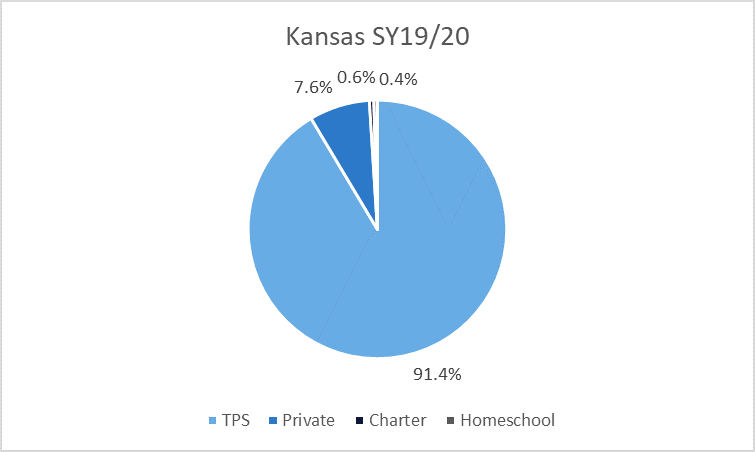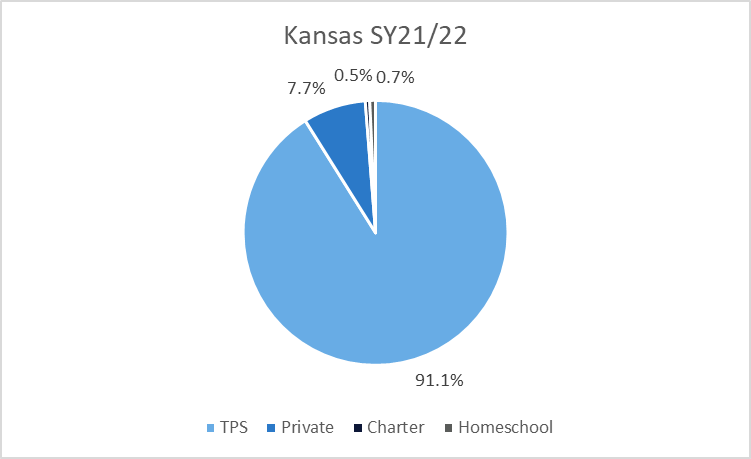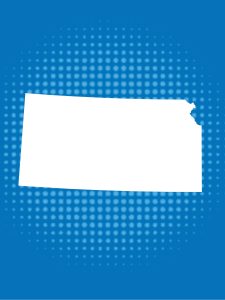In Kansas, homeschooling is called a “nonaccredited private school,” but it looks similar to homeschooling in other states.
History
Kansas is in the midwestern region of the United States and legalized homeschooling in 1982. Kansas classifies homeschooling as a “nonaccredited private school.” However, this moniker also applies to other more traditional brick-and-mortar type schools that are private and not accredited by the state board of education. Therefore, a clear understanding of traditional homeschool participation is difficult in Kansas.
In 1996, Kansas modified the homeschool policy, which allowed parents to retain the fundamental right to exercise primary control over the care and upbringing of their children. Then, in 2022, another bill passed the Senate to give parents the explicit right to oversee their children’s education. However, the bill was not passed in the House.
Regulation
Kansas offers one option for students to homeschool. In Kansas, families with children ages 7 to 18 homeschool by creating a nonaccredited private school. They must register their school’s name and address with the State Board of Education. There is no cost associated with creating or filing the school, and no state approval process. Further, parents must only register their homeschool once and can report a status change to the state if the homeschool “closes” or becomes inactive.
While there are no specific hourly or daily requirements, homeschooling parents are expected to provide instruction for a period of time substantially equivalent to the time public schools are in session. They are further recommended to keep accurate records in case the student transfers to a public school. There are also no minimum parent-educator requirements, only that there is a “competent instructor.” Additionally, there are no subject or testing requirements. These policies align with the requirements of any private school in the state.
All nonpublic students in Kansas have broad and funded access to public school offerings such as courses, extracurriculars, and sports; that right is explicitly defined in statute. For example, homeschooled students can enroll part-time or take courses at their public school; these offerings are publicly funded. All nonpublic students, including those in homeschools, can access special education services in their assigned districts and may be able to access services in other districts depending upon local approval.
State Data
While Kansas collects information on homeschool families, it is difficult to separate the private schools as homeschools from the more traditional private schools. As such, we have limited information on homeschool participation in the state. Further, homeschool families only report their information once. Researchers with The Washington Post recently collected some homeschool participation data from 2017 to 2023. These data indicate that around 7,000 students were homeschooled in 2020-21.

The Household Pulse Survey by the U.S. Census is the best available state-level information on Kansas homeschool participation. Evidence shows that approximately 2.4% of Kansas families reported homeschooling in the spring of 2020, growing to 10.1% by the fall. As seen in other states where homeschooling is called “private school,” the initial participation percentage in 2020 was quite low compared to the national average of 5.4%. It is possible that folks were under-reporting because homeschool families in Kansas identify as private schools. This question was modified in the second administration, potentially correcting for some misunderstanding of what was and was not considered homeschooling. Based on U.S. Census data, our calculations indicate that about 5.77% of K-12 students in Kansas were homeschooled during the 2022-23 school year, and 5.37% during the 2023-24 school year. Due to survey changes, the data from 2020 reflects the percentage of households, while the data from following years reflects the percentage of students.
Cross-Sector Comparison
During the 2019-20 academic year, 0.4% of Kansas’ K-12 students were homeschooled. Similarly, 0.6% of students in Kansas attended a charter school. Both homeschool and charter school participation in the state were much lower than the 7.6% of students attending private schools. In 2021-22, cross-sector participation remained similar, with homeschool attendance at 0.7%, charter school attendance at 0.5%, and private school attendance at 7.7%.


School Choice Context
In addition to homeschooling, parents in Kansas have various educational choices available. These options include traditional public schools with inter- and intra-district choice, one small voucher program, limited charter schools, magnet schools, and virtual learning programs. Kansas has one tax credit program for low-income families. It appears that homeschooled students might qualify, but only if they attended a public school the year prior or are under seven years old.
Commentary
Kansas has some of the broadest access to public school offerings of any state in the nation. However, if the state collects information from private school families, it would help transparency to include a mechanism to separate homeschool private schools from other private schools. This small change would improve our understanding of homeschool participation in the state and the nation, thus driving more informed policy.

-
10.1% Families
Around 10.1% of families in Kansas homeschooled during the height of the pandemic (Fall 2020).
-
1982 Legalized
Homeschooling was legalized in 1982 in the state of Kansas.
-

-
More Information
10.1% Families
Around 10.1% of families in Kansas homeschooled during the height of the pandemic (Fall 2020).
1982 Legalized
Homeschooling was legalized in 1982 in the state of Kansas.

More Information
Last updated March 2025.